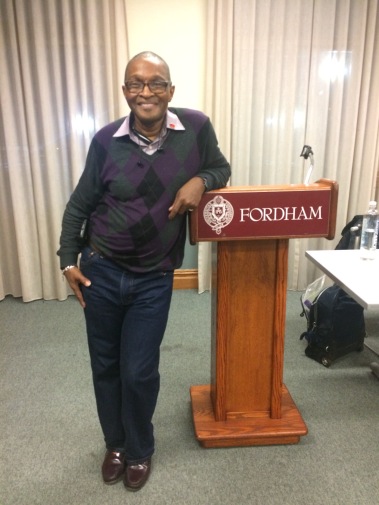By Ashley Katusa

Dennis Baron shared his story of homelessness in New York City. Ashley Katusa/The Fordham Ram
Homeless and on the street to a deacon of a church – this is the personal transformation Dennis Barton shared with the Fordham community at a Fordham Club discussion last Thursday. Barton, a member of the Interfaith Assembly on Homelessness and Housing, and Dr. Susan Greenfield, a member of the Fordham English Department, hosted the discussion regarding hunger and homelessness in New York City.
Dennis Barton lived on the streets of New York from 1983-1999. He then spent three years in a shelter, bringing his amount of time being homeless up for 19 years.
While speaking of his birth in the South Bronx to a single parent, his friendly, jovial tone turned somber. “When my mom went into the hospital to have me, she didn’t expect her son to become a homeless drug addict,” he said.
Barton’s struggle with homelessness began in a jail in February of 1980. In this time, he focused himself on obtaining his GED, scoring the highest grade in the state for that quarter. Due to his success, the prison enrolled him in a college program on an educational release condition – he would attend school all day, then go back to prison at night.
However, once he was released, Batron did not have a job or school to focus his energy on.
“For the next 14 years I’d be homeless on the streets of New York City,” he said.
Barton’s tale is not entirely unique. According to recent polls conducted by the Coalition for the Homeless, 59,305 individuals in New York are sleeping in homeless shelters. This number doesn’t account for individuals in domestic violence shelters, faith shelters, AIDS shelters, the runaway youth, and individuals sleeping on the streets.
Barton told students of how people would donate materials to him in exchange for performing odd jobs. Rather than feeling embittered, he was inspired. “I saw the goodness and charity in people,”he said. He described how he slept in trains, parks, and rooftops, and sometimes ate from dumpsters, humorously delivering a story about how he would race to McDonald’s to be the first in line for the Big Macs they threw away at the end of the day.
In 1999, Barton lived in a homeless shelter, an experience he described as more than mildly unpleasant.
“I felt more comfortable in prison than I did in that shelter,” he said.
He decided he would do something about his situation and chagne his fate.
“That was the turning point for me,” he said. “I’m 49 years old, my life has been a mess, I’m living on the streets, and my children are growing up without me.”
Eight years ago, he was ordained deacon in the Collegiate Church of New York system. He works as a parent workshop facilitator, and is a peer facilitator at Planned Parenthood.
Despite having a happy ending, Barton’s story was one of trials and tribulations. “I’ve been shot, stabbed, addicted, and homeless…but yet I’m still here,” he said. “Today, I’m no longer living on the streets. I’m no longer sleeping on the subways. I have all of my children back in my life. Today, my life is so much better.”
His final piece of advice was for students to get involved with midnight runs, soup kitchens and other charitable organizations in order to fight the poverty and homelessness in New York City.
